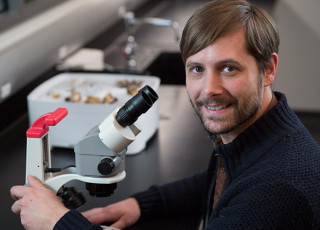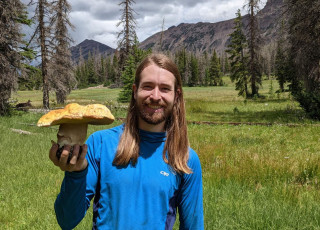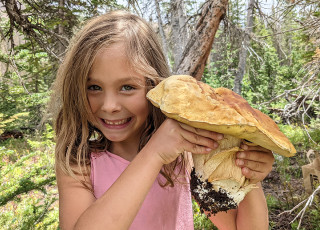What a Giant Fungus Can Teach Us About Cancer
One of many growing fungal cultures of the Humongous Fungus maintained by Alex Bradshaw in the genetics lab at the Natural History Museum of Utah. Photo © NHMU.
By Kendra Autumn
Malheur National Forest in Oregon is home to the world’s largest known organism--surpassing blue whales and giant sequoias, an extensive underground fungal network covering over three square miles wins the prize. This network comprises the Humongous Fungus, an individual belonging to the genus Armillaria. Like other mushroom-producing fungi, Armillaria exists primarily as a mass of threadlike fungal cells called a mycelium, occasionally producing mushrooms aboveground to disperse its spores. However, the Humongous Fungus itself has never been known to produce mushrooms. Alex Bradshaw, a biology graduate student at the University of Utah, is conducting research in the Natural History Museum of Utah’s genetics lab to uncover the secrets of how this fungus lives and grows. But this is more than just an intriguing case of fungal gigantism: Alex’s work has potential to lend insight into how cancer lives and grows as well.
To understand the Humongous Fungus’ medical relevance, we need to consider the differences between individuality as applied to an animal, like a human, and individuality as it pertains to a fungus. A fungal mycelium can be broken apart and the resulting pieces will continue to grow, a feat no human can emulate. These new mycelia are genetically identical, and can fuse back together if they meet each other again. Are they all different individuals? Physiologically, they may be separate, but when reintroduced, they recognize each other as “self”.
If two genetically distinct fungi meet, they do not recognize each other as “self” and merge. Instead, they create border zones of chemical warfare in a process called somatic incompatibility. A foreign fungus is a threat, and fungi have adapted to be able to tell the difference between themselves, including physically separated pieces of themselves, and an enemy that could jeopardize their resources.
Humans, like most (but not all) animals, can only reproduce sexually. This means that when a mutation changes some of the DNA in one of our somatic (body) cells, that somatic cell’s new genotype won’t be passed on to our offspring. Only mutations that affect our sex cells, or gametes, will be transmitted to the next generation. “The somatic cells themselves have no way to alter the gametes to pass on any changes,” explains Alex. “That genetic variation will never be passed on.”
However, a somatic mutation in a fungus is an entirely different story. A fungus’ hyphal “roots” are only a cell thick and grow continually outwards, so a mutation in a somatic cell could be carried forward in all the hyphae it gives rise to. A large section of the mycelium could have a different genotype from the rest of the organism, making the fungus a genetic mosaic. This further complicates our concept of fungal individuality, since genetic homogeneity within a physiologically connected organism is no longer a given. A genetically mosaic organism theoretically could experience competition between its different genotypes, leading to natural selection within an individual.
In the lab, Alex is currently testing somatic incompatibility between cultured mycelium from different parts of the Humongous Fungus to see if spatially separate samples merge or fight. Eventually, he will use DNA sequencing technology to characterize the genetic differences between the samples.
Do animals/humans have any comparable phenomena where one cell genotype competes with another? Yes: Cancer can be thought of as ”rogue cells” perpetuating their genotype at the expense of the overall organism. The somatic mutations in a cancerous cell are passed on to its offspring cells through its rapid and unchecked replication.
Multicellularity in animals requires cooperation between cells, and animals have evolved ways to coerce cells into working together for the good of the organism. “Cancer cells have become unlocked from that system and gone haywire,” says Alex. Understanding how cells with different genotypes interact in the Humongous Fungus, including potential cell-cell competition, could provide important insight into the ways cancer persists and grows in humans. Research museums such as the NHMU facilitate work like Alex’s by connecting the natural world to human interests, encouraging creative perspectives on how we can better make sense of ourselves, nature, and the places where the two intersect.
Read the latest mycology news from NHMU on our blog.
Kendra Autumn is a PhD student doing research at the Natural History Museum of Utah a part of the University of Utah in Salt Lake City. Our mission is to illuminate the natural world and the place of humans within it. In addition to housing outstanding exhibits for the public, NHMU is a research museum. Learn more.



